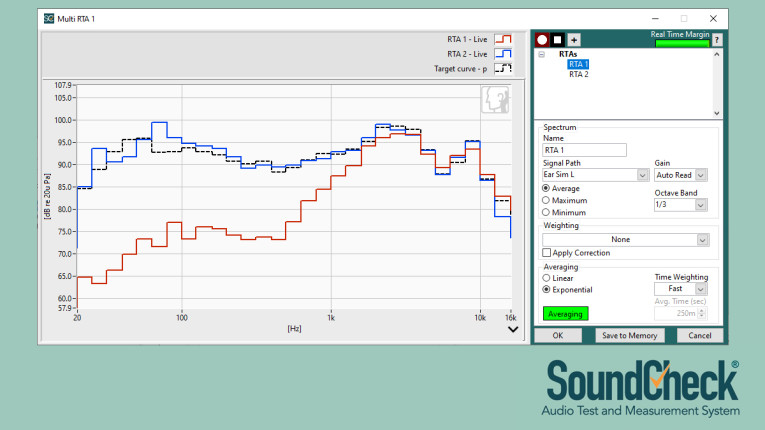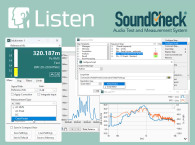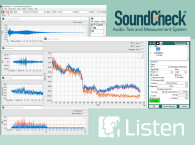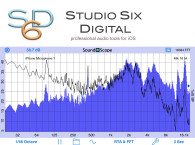
Listen traditionally introduces a new version of SoundCheck each year, but its users are still appreciating all the new features and upgrades since the release of SoundCheck 19 in 2021, including much tighter integration with hardware, including with Listen’s newest AmpConnect 621 interface, supporting multichannel, multifunction, and high resolution audio functionalities.
audioXpress readers have learned first about the upcoming SoundCheck 20 update and the new enhanced Perceptual Rub & Buzz distortion algorithm, which is a complete game changer for production line quality control. audioXpress published a preview in its “Test and Measurement Market Update” article, audioXpress March 2022; and a feature article “The Evolution of Production Line Rub & Buzz Measurements” article by Steve Temme in audioXpress April 2022 - highly recommended reading.
The main update in SoundCheck 20, the new Enhanced Perceptual Rub & Buzz algorithm, introduces a reliable and repeatable method of detecting audible Rub & Buzz faults on the production line. Without repeating all the details explored in the above mentioned article, Listen’s new Perceptual Rub & Buzz algorithm offers manufacturers the option to increase yield by rejecting only those devices with audible distortion defects.
Based on the sound psychoacoustic principles used in Listen’s industry-standard 2011 Perceptual Rub & Buzz algorithm, the new refinements improve listener correlation and demonstrate significantly better noise rejection to offer unrivaled repeatability. This makes limit setting easier and increases reliability, especially in production environments. The algorithm measures perceptual Rub & Buzz at the same time as all other end-of-line measurements with a single stepped sine wave stimulus, enabling this valuable analysis to be added to production line tests with no extension in test time.

Traditionally, SoundCheck was always a very powerful solution for loudspeaker testing, but the latest update expands even more the features required for audio measurement and full characterization of smart speakers, infotainment systems, headphones and hearables, and other voice-activated and multichannel devices, including communications testing.
Meanwhile, the multichannel Real Time Analyzer (RTA), initially introduced in 2020, was upgraded with real-time calculations. This way, the multichannel RTA includes expanded functionality for real time observation of audio signals, is now able to display multiple channels simultaneously, and offers real time calculation and display of channel addition, subtraction, maximum, minimum and power average. Applications for this new feature include real-time observation of active noise cancellation, automotive industry standard 6-microphone array infotainment measurements, validating headphone seal on a test head prior to measurement by comparing left and right earphone response, and more.

Paired with the AmpConnect 621 multichannel audio interface, it offers unmatched functionality for multichannel measurements on a wide array of devices, especially those featuring dynamic signal processing. RTA curves are now seamlessly integrated with SoundCheck’s standard graphs. Live curves from the RTA are displayed in the memory list and can be dragged and dropped into any graph for easy comparison to limits and reference curves. This is useful for quick comparisons to reference standards or golden units, tuning automotive infotainment systems, and more.

There’s also a complete overhaul of the signal generator that brings additional functionality and simplified operation, particularly when using wav files. In addition to standard audio stimuli (sine, white noise, pink noise, multitone) with user-selected sampling rates and resolution, it can play any wav file, any memory list file, and any complex waveform created by the stimulus editor. The level can be referenced to Peak, dB or RMS. The signal can be equalized in real time, and custom EQ curves applied, which is useful when using a non-flat source such as a mouth simulator.
A specific portion of a waveform can be selected to play, either by selecting a start and stop time in seconds, or by examining the waveform. Outputs from 2 or more signal generators can be mixed on the same channel. Waveforms from multiple signal generators can be synchronized, or a delay added for non-coherent playback, for example when generating background noise. Signals may be played for a fixed duration, a fixed number of times, or in a continuous loop. Finally, slider control, in addition to numerical entry, simplifies use.
Of great interest for perceptual measurements of speech degradation in communications applications ranging from telephones to smart devices, a new optional module now brings POLQA (Perceptual Objective Listening Quality Analysis) analysis right into SoundCheck. This module may be used to assess the impact of noise reduction algorithms, evaluate Bluetooth degradation due to packet loss, or to analyze distortions introduced into the audio path. Naturally, it can be used within sequences to accelerate and simplify test procedures.

And while SoundCheck has offered batch processing of collected data since 2012, version 20 extends this with the ability to automatically load and process external data. This is useful in any application where it is desirable to automate the testing of a large number of external data files via a sequence, for example wav files of speech recordings. This has many uses in communications testing, for example in testing the Mean Opinion Score (MOS) of degraded speech files.
For communications testing, users can now explore the new stimulus steps and post-processing capabilities such as a silence stimulus step, and RMS level versus time and histogram post-processing steps. This allows measurement of Doubletalk and other speech transmission parameters. A pre-written test sequence for categorizing Doubletalk performance to two international standards, ITU-T P.502 and ETSI TS 126 132 (part #3114) is also available. The silence step inserts a user-defined zero-amplitude signal before or between active signal levels of a compound stimulus step. This is used to synchronize two or more signals in a stimulus step based on measured delays in the device under test.
The Level vs Time Post Processing step computes the RMS level over time of the selected waveform or group of waveforms within a sequence. The Histogram Post Processing step calculates the histogram of a waveform and outputs two curves, the histogram, and the complementary cumulative distribution. This is used for any non-stationary signal analysis such as echo detection in telecommunications or background noise evaluation.
The stimulus editor can now create a stimulus from any waveform in the memory list and equalize and adjust its level, for example using active speech level. This enables such adjustments to be made to externally acquired test signals, such as those imported into SoundCheck via TCP/IP or recall steps. This is particularly useful for smart device certification testing.
It is also now possible to export multiple SoundCheck recorded waveforms to a single multichannel wav file. This is useful for maintaining channel identification when playing back a multichannel wav file on a device that can only play wav files.
There is also a new hardware reset option in the setup wizard that allows audio interfaces to be changed without the need to reconfigure channels, and offers a fast way of restoring hardware to a known configuration.
For a limited time Listen is offering deep discounts on a system upgrade/support contract package to enable users to start working with SoundCheck 20. Full details are available here , or by email contact.
www.listeninc.com







